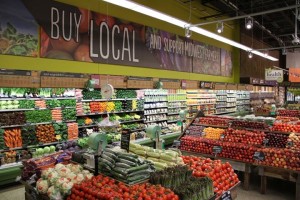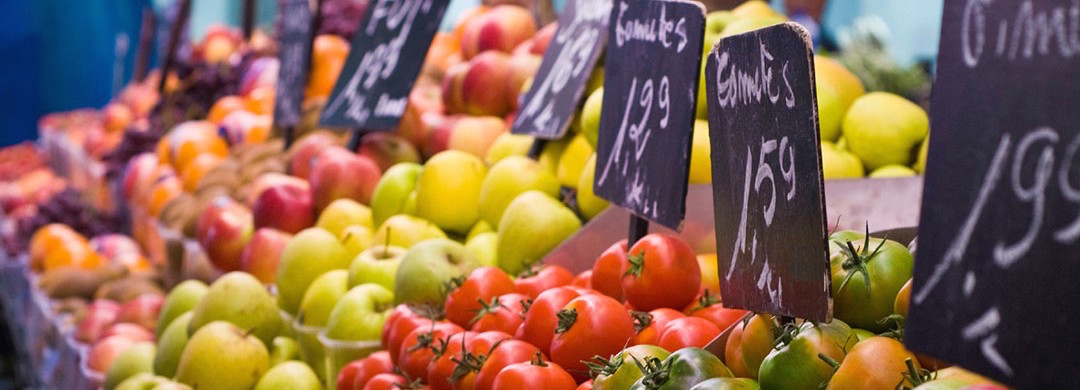Local Foods Drive Massive Growth in Retail
Retailers are sourcing food products from local suppliers to simplify supply chain management, save time and transportation costs, and build goodwill within their communities.
In the ultra-competitive grocery channel where freshness matters most, there’s no place like (close to) home.
Consumers have such a voracious appetite for local foods that shoppers who enthusiastically embrace the local food movement are now called “locavores.” This lucrative local foods market generated $11.7 billion in sales in 2014, and will climb to $20.2 billion by 2019, according to market research firm Packaged Facts.1
What is considered “local”?
While there is no universal, standard definition of “local,” consumers are almost unanimous on one geographic constraint. According to recent research by consulting firm A. T. Kearney, 96% of U.S. consumers describe local food as products grown or produced within 100 miles from the point of sale, up from 58% in 2014.2
In addition, local foods now reflect a broader product assortment. Today’s consumers – especially women and young people – have come to expect high-quality local meat, seafood, and produce, as well as jams, ice cream, and bread.3
Factors fueling the hunger for local foods
- Millennials love local: Today’s Millennials, who account for 24% of the U.S. population (77 million), value authenticity and locally made products.4 They are leading the “buy local” movement, a $29 billion industry for both food and non-food products, which has doubled in size in the last 10 years, according to AdWeek. Edelman Digital found 40% of Millennials prefer to shop local, even if it costs more.
“Retailers are sourcing food products from local suppliers to simplify supply chain management, save time and transportation costs, and build goodwill within their communities.”
- Consumers associate local with “fresh”: Nearly all consumers (93%) associate local with “fresh,” the primary purchasing factor for grocery consumers.5 That may explain why, regardless of the category, 78% of consumers are willing to pay a premium of 10% or more for local food, up from 70% in 2014.6 Surprisingly, even lower-income grocery shoppers say they (63%) would pay more for local food.7 The availability of local foods also impacts retailers’ brand loyalty, as almost 30% of grocery shoppers say they consider purchasing food elsewhere if their preferred store does not carry local foods.8
- Farmers markets: Strong demand for local foods has driven the 350% increase in the total number of farmers markets between 1994 and 2013, according to the U.S. Department of Agriculture (USDA). This explosive growth has prompted suppliers, grocers and restaurants to adapt by adding locally produced food offerings all year round.9
The diverse benefits of local sourcing
The trend toward locally sourced food products benefits businesses and consumers alike. By working with local suppliers, grocery retailers simplify their supply chains, which boosts certainty and predictable delivery, and lowers transportation costs. Local sourcing can also distinguish retailers’ brands and lead to flattering PR by demonstrating their investment in jobs in the local community.
Local suppliers benefit from increased speed to market by selling to nearby retailers. Also, since suppliers are literally closer to their end consumers, they can promptly apply shopper feedback and adapt their products to satisfy local preferences.
Buying local foods helps consumers feel good. Choosing products sourced closer to home allows consumers to support people in their community. These products also often align with consumers’ environmental and ethical demands and expectations.
Market leaders invest in local foods
The massive growth in demand for local foods has captured the attention of retail leaders and shaped their purchasing strategies.
Retail giant Walmart is the largest purchaser of locally sourced and sold produce in America, selling $749.6 million of locally grown produce annually; Supervalu buys between 25% and 40% of its produce locally, according to A.T. Kearney.10
Whole Foods Market remains committed to buying from local producers that meet its quality standards and some regional stores have an employee known as a “forager,” whose sole duty is to source local products for each store.
3 ways to win with the local food movement
- Be authentic: To attract Millennial shoppers who lead the “buy local” movement, suppliers and retailers can help them feel an emotional connection to their brands by sharing the history and heritage of local products.11 Companies can use packaging, as well as in-store and digital communications to share their meaningful brand stories.
- Share facts: Voluntarily offering product data can build brand trust, as Millennials and locavores want proof of how, when and where products were made.12 13 As such, companies should proactively and transparently share more detailed information about their local products.
 Emphasize “fresh”: In grocery, product freshness and quality are paramount. When displaying regular and local alternatives, retailers should distinguish local products with signage that states its local origin to benefit from the perception of superior freshness and quality. For similar reasons, suppliers should use their packaging as a marketing opportunity to state the location of their product’s origin.
Emphasize “fresh”: In grocery, product freshness and quality are paramount. When displaying regular and local alternatives, retailers should distinguish local products with signage that states its local origin to benefit from the perception of superior freshness and quality. For similar reasons, suppliers should use their packaging as a marketing opportunity to state the location of their product’s origin.
Using local foods for superior customer experience
This year, grocery retailers and food suppliers should build strategic relationships with companies in their area. To capitalize on the growing local food movement, these companies should: respect the tremendous purchasing power of Millennials; capitalize on consumers’ association between local and fresh foods; expand product offerings across categories so local foods are available all year round; and share brand stories and facts to build brand engagement and trust.


No comments:
Post a Comment